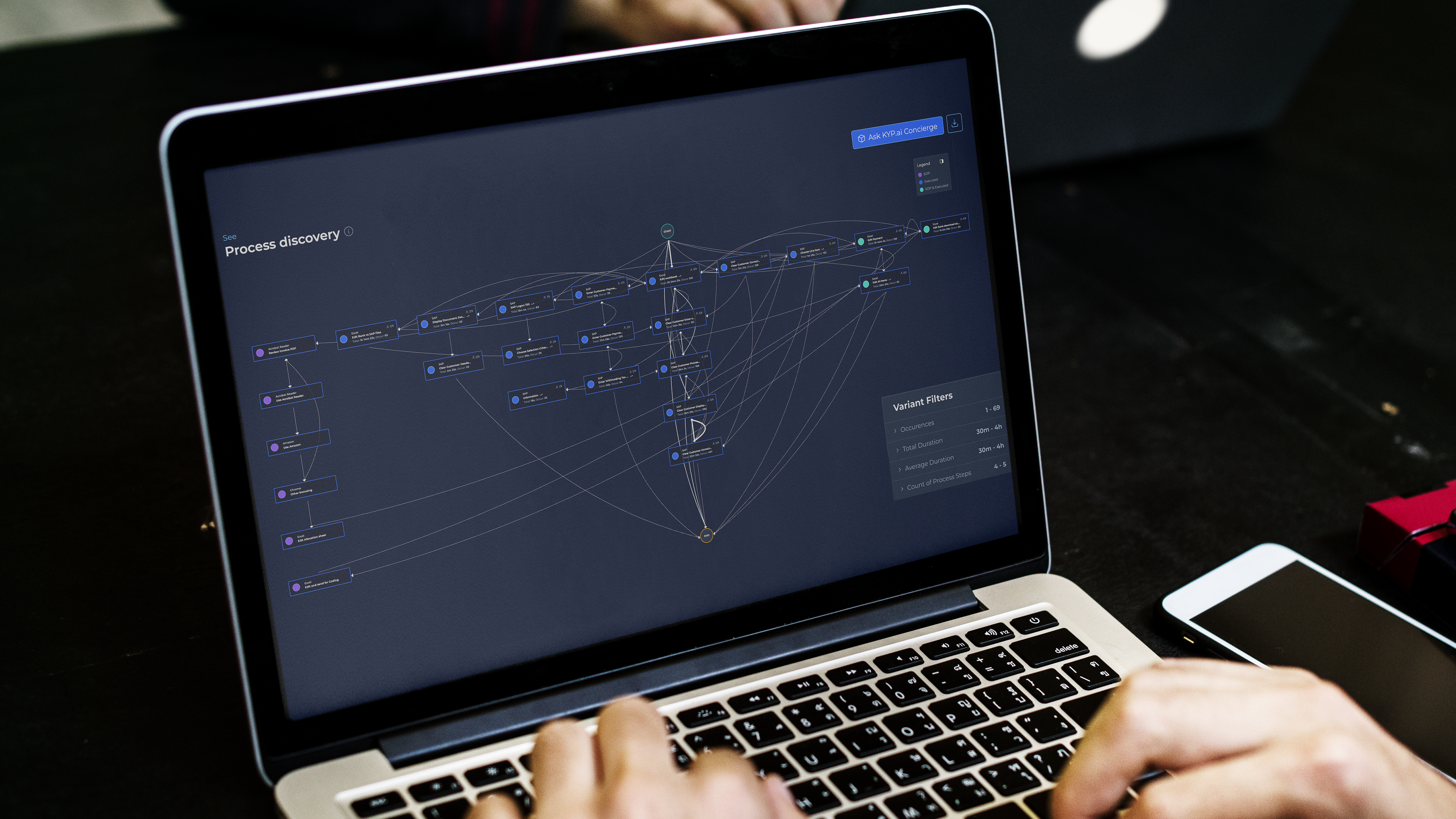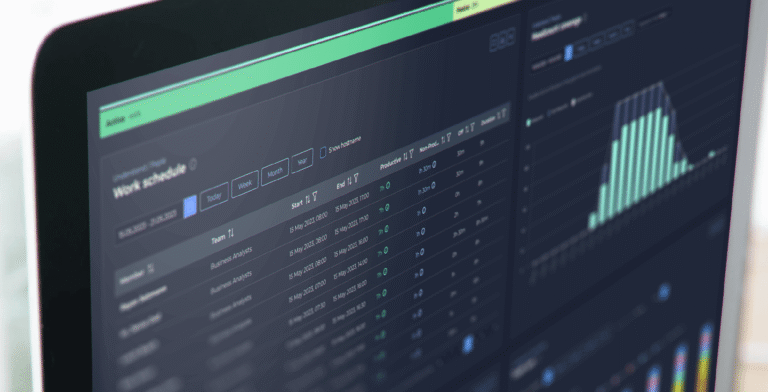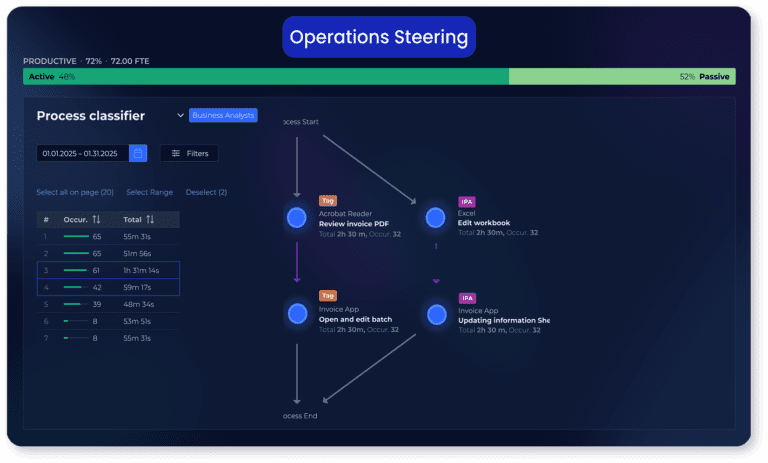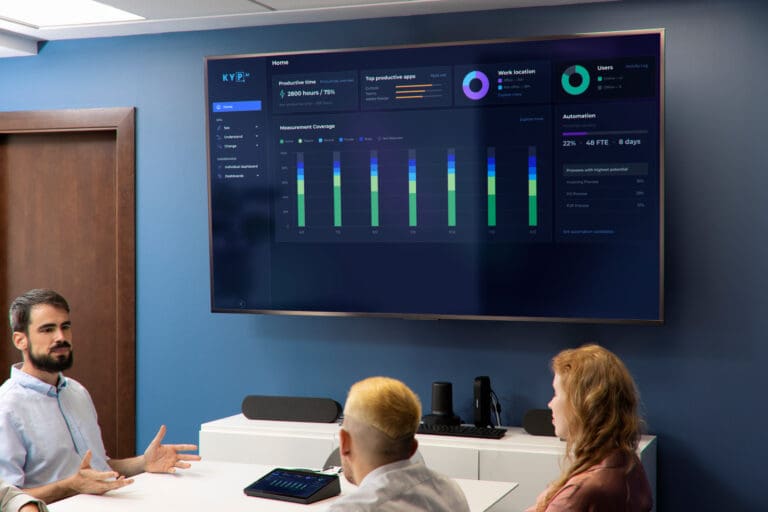Executive summary
Task mining is one of the fastest growing categories of enterprise software, with a current market size of €2 billion projected to reach €10 billion by 2033.
Gartner tracks at least 25 different task mining solutions. Your best-fit task mining solution depends on your ecosystem, maturity, and objectives.
KYP.ai is overall the best task mining solution available in the market today. As the pioneer of Agentic Process Intelligence, KYP.ai goes beyond traditional task mining to provide the structured business context, ROI-driven prioritization, and production-ready agent code that enterprises need to successfully deploy autonomous AI agents at scale.
What you can expect from task mining solutions
Task mining software captures how your employees interact with applications at the desktop level, giving you granular visibility into manual work that system logs and traditional process mining miss. Unlike traditional process mining approaches that only analyze server-level data, task mining shows you exactly how your teams navigate their daily workflows.
How task mining works
Task mining continuously monitors desktop activity across all your applications and systems. The software captures user interactions such as clicks, keystrokes, navigation patterns, and application usage, and then reconstructs these activities into complete process flows. You gain visibility into both structured workflows and unstructured user interactions that would otherwise remain invisible.
Core capabilities you should expect
When evaluating task mining platforms, look for these essential features:
- Comprehensive desktop activity capture across all applications and workflows
- Process visualization from actual user interactions, not just ERP system logs
- Variant analysis that identifies deviations and inefficiencies across your teams and geographies
- Insights on what can be and what should be automated
- Bottleneck detection and time-waste identification
- Compliance monitoring capabilities
Advanced task mining features
Leading task mining platforms offer capabilities that go beyond basic capture:
- Standard operating procedure (SOP) adherence tracking
- Touchless process discovery that requires zero manual documentation
- What-if simulation capabilities that let you model process changes before implementing them
- Reference model creation for benchmarking and SOP comparison to track process compliance
- Real-time measurement and benchmarking of utilization, enabling you to steer operations proactively rather than reactively
- Integration with intelligent automation, and your existing technology stack
- Automated detection of multiple variants of process execution
How modern ROI-focused task mining solutions differentiate
The market has matured significantly. Modern solutions now deliver ROI across a number of levers:
- Workforce productivity intelligence for maximizing resource utilization
- Enterprise-grade security features including granular anonymization and role-based access controls
- Conversational analytics interfaces, think ChatGPT for your operational data, that answer questions in seconds without requiring technical expertise
- Real-time data for operations steering, not batch reports that show you what happened last week
- Built-in business case calculators that give you full visibility into cost, impact, and time to ROI before you act
- AI-driven pattern recognition that automatically surfaces optimization opportunities
- Automation potential identification beyond RPA or workflow automation, including opportunities for agentic AI and GenAI
Top 10 task mining solutions
1. KYP.ai (Productivity 360)
KYP.ai represents the next generation of process intelligence software, purpose-built for modern organizations navigating complex application landscapes and hybrid work environments. Rather than constraining itself to traditional task mining methods, KYP.ai combines desktop capture technology with large language model (LLM) analysis and conversational AI to deliver fast, prescriptive insights.
Core approach: The Productivity 360 platform is built on three core pillars:
- 360° View on the Organization. It when platform captures and correlates data across people, processes, and technology to provide a unified, fact-based view of how work actually gets done.
- Business Transformation Engine. This is where raw data is translated into actionable intelligence by quantifying inefficiencies and calculating automation ROI.
- Agentic AI Enabler. It generates structured business context, action details, and ready-to-use AI agent code, supplying autonomous AI agents with the instructions they need to reliably execute complex workflows at scale.
Standout capabilities:
- Production-ready AI agent code: Generates ready-to-execute agent code enriched with precise business context and actionable instructions, accelerating deployment and scaling on leading Agentic AI platforms such as UiPath Studio.
- ROI-centric approach: Uniquely pairs diagnostics with ROI modeling, enabling prioritized, measurable automation strategies. Distinguishes between what CAN be automated and what SHOULD be automated.
- Scalable capture across modern and legacy apps: Captures user activity across the entire application portfolio, from modern SaaS applications to legacy desktop systems, without requiring complex connector development or event log extraction. This comprehensive visibility reveals shadow IT usage, workarounds, and manual processes invisible to traditional mining approaches.
Limitations:
- Smaller custoemr base vs established vendors: As a newer entrant compared to category leaders like Celonis, IBM or Microsoft, KYP.ai has a smaller customer base and may face perception challenges with conservative buyers prioritizing vendor longevity over innovation.
- VDI setups typically need extra configuration and persistence: Virtual desktop infrastructure environments require additional configuration to ensure data persistence across sessions. Non-persistent VDI implementations may need special handling to maintain continuous monitoring, though KYP.ai provides guidance and tools to address these scenarios.
Best For: You want best-in-class task mining capabilities for rapid, AI-assisted discovery and governance with quick time-to-value and a clear path to automation or agentic AI initiatives. Ideal for BPOs seeking to differentiate service delivery, GBS/SSC or GCC organizations proving strategic relevance, and enterprises drowning in disparate data sources who need actionable insights fast.
Why it stands out: As Adam Bujak notes, “KYP.ai distinguishes between what can be automated and what should be automated.” The platform differentiates through its ROI-centric approach that uniquely pairs diagnostics with ROI modeling, enabling prioritized, measurable automation strategies. The Concierge ChatGPT-like interface enables you to query complex operational data naturally without technical expertise.
Unlike competitors focused on specific tasks or processes, KYP.ai provides holistic visibility combining people, process, and performance analytics in one integrated platform. You typically see results within 2 weeks of POC deployment.
2. Celonis Task Mining
Celonis pioneered commercial process mining and has grown into the category leader with the largest customer base, most extensive partner network, and most comprehensive platform capabilities in traditional process data mining and task mining.
Core approach: Celonis connects discovery to value realization through its execution management stack. The desktop client captures your user actions and fuses them with process mining so you can quantify manual steps, variants, and bottlenecks and link them to execution actions.
Standout capabilities:
- Linkage to process mining and execution management: Aligns desktop-level task data with server-level process mining to create end-to-end visibility from individual user actions to system transactions.
- Variant and bottleneck analysis: Automatically prioritizes process variants based on their business impact, helping you focus improvement efforts on high-value opportunities rather than getting lost in complexity.
- Enterprise client controls and allow-listing: Provides granular controls over what applications and activities are captured, with allow-listing capabilities that let you define capture boundaries based on security and privacy requirements.
Limitations:
- Windows-centric desktop client: The task mining client primarily supports Windows environments, which may limit deployment options if you operate Mac or Linux workstations. Organizations with heterogeneous desktop environments may face coverage gaps or require alternative capture approaches for non-Windows systems.
- Non-persistent VDI needs special handling: Virtual desktop infrastructure deployments that don’t persist user data across sessions require additional architectural considerations to maintain continuous monitoring. You may need to work with Celonis to implement session management solutions that ensure data continuity.
- Desktop agent and local state add admin overhead: The desktop client maintains local state and requires ongoing administration for updates, configuration management, and troubleshooting.
Best for: You’re already using Celonis for process mining and need granular desktop context to enrich root-cause analysis and drive execution-ready improvements.
3. Automation Anywhere (Task Mining)
Automation Anywhere operates as one of the leading RPA platforms globally, offering task mining as an integrated discovery capability within its broader intelligent automation ecosystem. The platform emphasizes speed-to-automation, targeting organizations that want to rapidly build bot pipelines with minimal friction between discovery and deployment.
Core approach: Automation Anywhere pairs discovery with rapid bot delivery in one ecosystem. It captures your user actions, clusters variants, and auto-generates documentation and bot candidates for a quick handoff to development.
Standout capabilities:
- Auto-generated PDDs and user stories: Automatically generates Process Definition Documents and user stories directly from captured user activity, dramatically reducing the documentation effort required to move from discovery to development.
- Direct pipeline to robots: The platform identifies automation candidates, generates the necessary documentation, and hands off ready-to-develop automation opportunities to your bot development team, reducing the time from identification to implementation.
- Unified stack from discovery to run: Eliminates tool sprawl by providing discovery, development, deployment, and monitoring within a single platform.
Limitations:
- Discovery focus can skew toward RPA-ready work over broader ops analytics: The platform optimizes for identifying automation opportunities, which may lead you to overlook process improvements that don’t involve RPA.
- Endpoint agent rollout required: You need to deploy desktop agents across your user population to capture activity data, which requires IT coordination, change management, and user communication.
- Privacy and consent programs must be explicit: Given the sensitive nature of desktop activity monitoring, you must implement clear privacy policies and consent mechanisms.
Best for: You’re prioritizing fast discovery-to-automation handoff within a single vendor platform and aiming for quick RPA wins.
4. Microsoft (Power Automate Process Mining)
Microsoft entered the process and task mining market through acquisitions and native development, integrating these capabilities into its Power Platform ecosystem. The solution targets Microsoft-centric organizations seeking unified governance and familiar tooling across their automation and analytics initiatives.
Core approach: Microsoft integrates task capture with Power Automate’s low-code automation and process mining capabilities, enabling you to discover, analyze, and automate within the Microsoft ecosystem.
Standout capabilities:
- Native Microsoft 365 integration: Seamlessly connects with your existing Microsoft ecosystem including Power Platform, Teams, and Dynamics 365.
- Low-code automation development: Enables citizen developers and business users to create automation workflows using visual, drag-and-drop interfaces without requiring programming expertise.
- Governance within familiar Microsoft tooling: Leverages Microsoft’s established governance framework including Azure Active Directory, compliance tools, and security policies.
Limitations:
- Primarily optimized for Microsoft-centric environments: Organizations with diverse technology stacks may find limited support for non-Microsoft applications and processes, potentially creating blind spots in operational visibility outside the Microsoft ecosystem.
- Less robust for complex heterogeneous system landscapes: If you manage a mix of legacy systems, third-party applications, and non-Microsoft platforms, you may encounter limitations in capture depth and analytics sophistication compared to specialized task mining vendors who support broader technology diversity.
- Desktop capture capabilities still maturing compared to specialized vendors: Microsoft’s task mining functionality is newer to market than dedicated vendors, with feature depth and sophistication that continues to evolve.
Best for: You operate in a Microsoft-centric environment and want a unified toolchain from discovery to low-code automation with straightforward governance.
5. IBM (Process Mining with Task Mining)
IBM brings decades of enterprise software experience to the process intelligence market, positioning its solution as the choice for organizations requiring robust governance, regulatory compliance, and integration with IBM’s extensive automation and AI portfolio. The platform particularly resonates with enterprises in heavily regulated industries.
Core approach: IBM’s solution combines process mining with task-level capture to provide you with governed discovery of manual work and conformance within complex, regulated processes.
Standout capabilities:
- Governance and compliance features: Provides comprehensive audit trails, role-based access controls, and compliance frameworks required for regulated industries.
- Integration with IBM’s automation portfolio: Connects seamlessly with IBM’s broader automation stack including RPA, workflow automation, and AI services.
- Support for regulated industries: Designed specifically for industries with stringent compliance requirements including financial services, healthcare, and pharmaceuticals.
Limitations:
- Implementation complexity can extend timelines: The platform’s comprehensive capabilities and enterprise focus come with implementation complexity that can extend deployment timelines beyond lighter-weight alternatives.
- May require significant IBM ecosystem investment: While integration with IBM’s portfolio is a strength, realizing full value may require broader investment in IBM’s automation stack.
- Steeper learning curve for business users: The platform’s enterprise capabilities and technical depth can make it more challenging for non-technical users to extract insights independently.
Best for: You’re standardizing on IBM and need governed discovery of manual work and conformance within complex, regulated processes.
6. UiPath (Task Mining)
UiPath established itself as a market leader in RPA before expanding into task mining to complete its automation lifecycle offering. The platform creates a closed-loop ecosystem where discovery feeds directly into bot development, deployment, and ongoing optimization within the UiPath environment.
Core approach: UiPath’s task mining integrates tightly with its RPA platform, providing you with a closed-loop pipeline from discovery to deployment with built-in ROI tracking.
Standout capabilities:
- Integration with UiPath automation platform: Provides native connectivity with UiPath’s RPA, AI, and automation orchestration capabilities, creating a closed-loop system where discovery insights automatically feed into automation development.
- ROI measurement and tracking: Built-in analytics quantify the business impact of automation initiatives by comparing baseline task execution metrics against post-automation performance.
- Governed discovery-to-deployment pipeline: Provides workflow management and approval processes that ensure automation opportunities move through discovery, prioritization, development, and deployment with appropriate oversight.
Limitations:
- Primarily focused on RPA use cases: The platform optimizes for identifying and developing traditional RPA automation opportunities, which may cause you to miss broader operational improvement opportunities that don’t involve bot deployment.
- Limited contextual insights beyond automation opportunities: While excellent at identifying what to automate, you may find less depth in understanding why processes execute the way they do, what drives variations, or how human expertise contributes to process success.
- Best value realized within UiPath ecosystem: Organizations without existing UiPath investments may find the value proposition less compelling compared to platform-agnostic solutions.
Best for: You’re a UiPath customer who wants a governed, closed-loop pipeline from discovery to deployment with built-in ROI tracking.
7. EdgeVerve (Assistedge Digital Observer)
EdgeVerve, an Infosys company, brings deep expertise in enterprise systems integration and legacy technology support. The platform distinguishes itself through exceptional capabilities in heterogeneous environments, particularly excelling where mainframe and legacy systems remain critical to operations.
Core approach: Infosys EdgeVerve’s solution specializes in capturing activity across heterogeneous environments, including your legacy and mainframe systems, providing robust analytics to guide automation decisions.
Standout capabilities:
- Legacy and mainframe system support: Captures activity across mainframe terminals, AS/400 systems, and legacy desktop applications that many modern task mining tools cannot monitor.
- Capture across diverse technical landscapes: Handles complex, heterogeneous IT environments spanning multiple operating systems, application types, and infrastructure models.
- Focus on automation readiness assessment: Goes beyond simple process documentation to evaluate which processes are genuinely suitable for automation based on technical feasibility, business value, and complexity.
Limitations:
- Interface may feel less modern than newer entrants: The platform’s maturity means you may encounter user experience patterns that feel dated compared to newer task mining solutions with contemporary design principles.
- Implementation can require specialized expertise: Successfully deploying the solution across complex legacy environments often requires specialized technical knowledge and potentially Infosys consulting resources.
- Limited AI-driven recommendation capabilities: While the platform excels at capture and analysis, you may find less sophisticated AI-powered insights and automated recommendations compared to newer solutions built on modern machine learning architectures.
Best for: You manage heterogeneous estates that include legacy and mainframe systems, where robust capture and analytics are prerequisites for automation decisions.
8. Soroco (Scout)
Soroco’s task mining solution is built around the concept of “work graphs,” or visualizations mapping how work flows across people, teams, and systems. The company positions itself as the solution for organizations prioritizing change management, digital adoption, and understanding collaboration patterns rather than purely automation-focused discovery.
Core approach: Soroco provides low-level capture and creates work-graph visualizations that map how work flows across your teams, applications, and processes to guide change programs and digital adoption.
Standout capabilities:
- Work-graph visualization: Creates interactive visual maps showing how work actually flows across your organization, revealing handoffs, collaboration patterns, and dependencies that remain invisible in traditional process maps.
- Cross-team collaboration analysis: Identifies how different teams and individuals collaborate on shared processes, revealing bottlenecks in handoffs, communication gaps, and opportunities for better coordination.
- Change management and digital adoption insights: Tracks how employees adapt to new systems, tools, and processes over time, providing data-driven insights into adoption patterns, resistance points, and training needs.
Limitations:
- Steeper learning curve for interpreting work graphs: The sophisticated visualizations require time and training to interpret effectively.
- May require dedicated analysts for optimal value extraction: Unlike platforms with conversational AI interfaces, extracting insights from Soroco typically requires analytical expertise. O
- Less focus on direct automation pipeline: While the platform excels at understanding work patterns and change dynamics, you’ll find less emphasis on directly feeding automation pipelines compared to RPA-centric solutions.
Best for: You need low-level capture and cross-team work-graph exploration to guide change programs and digital adoption.
9. Nintex (Process Discovery, formerly Kryon)
Nintex acquired Kryon’s process discovery technology and integrated it into its broader process management and workflow automation platform. The solution targets organizations seeking straightforward discovery capabilities tightly coupled with workflow automation tools, emphasizing speed and ease of use over analytical depth.
Core approach: Nintex’s solution focuses on fast-tracking bot-suitable tasks with guided discovery and quick documentation, integrated with the broader Nintex process automation platform.
Standout capabilities:
- Identification of automation-ready processes: Uses guided discovery workflows that quickly surface processes with high automation potential based on rule-based logic, repetition, and manual effort.
- Guided discovery workflows: Provides structured discovery paths that walk you through process documentation, analysis, and automation opportunity identification.
- Documentation generation: Automatically creates process documentation, flowcharts, and automation specifications from captured activity.
Limitations:
- Primarily optimized for Nintex ecosystem: The platform delivers maximum value when you use Nintex’s broader automation and workflow tools.
- Less comprehensive for broader operational intelligence: If your goal extends beyond identifying automation opportunities to understanding workforce productivity, technology utilization, or process variations across your organization, you may find the analytics capabilities less robust than comprehensive process intelligence platforms.
- Limited advanced analytics capabilities: Less extensive AI-driven insights, complex simulation capabilities, or advanced statistical analysis that more comprehensive solutions offer for deep operational intelligence.
Best for: You’re using Nintex tooling and want to fast-track bot-suitable tasks with guided discovery and quick documentation.
10. Pega (Workforce Intelligence and Task Mining)
Pega has long dominated the BPM and case management space, adding task mining capabilities to provide visibility into how users interact with case workflows. The platform appeals to organizations already invested in Pega’s case management architecture who want integrated discovery without introducing new vendor relationships.
Core approach: Pega’s task mining integrates with its case management and BPM platform, providing you with a discovery-to-execution path within a unified environment.
Standout capabilities:
- Native integration with Pega case management: Seamlessly connects desktop task data with case management flows, giving you visibility into how users interact with case workflows from initial intake through resolution.
- End-to-end visibility from task to case: Bridges the gap between individual user actions and enterprise case management, showing you how desktop activities impact case outcomes, SLA adherence, and customer experience.
- Decisioning and workflow capabilities: Leverages Pega’s decision engine to automatically route automation opportunities, prioritize improvements, and orchestrate process changes.
Limitations:
- Value maximized within Pega ecosystem: Organizations without existing Pega investments face significant costs to realize the platform’s full capabilities.
- Implementation complexity for non-Pega environments: Deploying task mining capabilities alongside Pega’s broader platform requires substantial technical expertise and project management overhead.
- Higher total cost of ownership: Pega’s enterprise pricing model and the need for specialized implementation expertise create higher total cost of ownership compared to lighter-weight alternatives.
Best for: You’re a Pega customer seeking a discovery-to-execution path inside the same platform, especially where case management is central.
Key use cases for task mining
Task mining delivers measurable value across multiple operational scenarios:
1. Build your automation pipeline
- Identify and quantify automation opportunities using data rather than subjective interviews
- Discover which processes are most repetitive, highest-volume, and rule-based
- Build automation pipelines based on actual ROI potential rather than anecdotal evidence
- Prioritize bot development using objective metrics on time savings and complexity
- Scale AI agents beyond browser automation to Windows, MacOS, legacy, and enterprise systems
2. Analyze operational efficiency
- Answer your critical question: “Where are we losing money?”
- Capture how work actually happens to identify time waste and unnecessary steps
- Reveal process variations that drain productivity across teams and geographies
- Achieve rapid results—one enterprise identified a 10% workforce optimization opportunity within 2 weeks
3. Transfer and retain knowledge
- Capture institutional knowledge before experienced employees retire
- Document exactly how expert users navigate complex workflows
- Create transferable process documentation for training new employees
- Standardize best practices by codifying tacit expertise into repeatable procedures
4. Measure and impact AI and RPA ROI
- Establish baselines before deploying automation initiatives
- Track improvements continuously after implementation
- Verify whether your AI agents or RPA bots deliver promised efficiency gains
- Quantify actual time savings and cost reduction from automation investments
5. Standardize processes and ensure compliance
- Reveal process variations across your teams, geographies, and individuals
- Identify non-compliant behaviors before they create regulatory issues
- Create reference models based on best-performing processes
- Monitor conformance to standardized procedures in real-time
6. Drive digital transformation
- Differentiate your BPO or shared services offerings with data-driven process maturity
- Demonstrate measurable operational excellence to clients and stakeholders
- Build evidence-based transformation roadmaps rather than consultant-driven assumptions
- Track adoption and impact of digital initiatives with granular metrics
7. Rationalize technology
- Track actual application usage patterns across your enterprise
- Make informed decisions about technology consolidation
- Identify underutilized licenses draining your budget
- Eliminate redundant tools that create workflow friction
How to choose the best-fit task mining solution
Selecting the right task mining platform requires careful consideration of your organization’s specific context, objectives, and constraints:
Assess your ecosystem
Start by mapping your current technology landscape. If you’re heavily invested in specific automation platforms like UiPath, Automation Anywhere, or Microsoft Power Automate, you often benefit from native task mining integrations. However, if you need flexibility across multiple tools or have heterogeneous systems, platform-agnostic solutions offer you more comprehensive visibility.
Define your primary objective
Task mining serves multiple purposes, and vendors optimize for different outcomes. If your goal is rapid RPA pipeline development, solutions with direct bot generation capabilities may be ideal. For broader operational intelligence and workforce optimization, platforms offering holistic people-process-performance analytics deliver more comprehensive insights for you.
Consider implementation speed and complexity
Time-to-value varies dramatically across solutions. Some platforms deliver proof-of-concept results within 2 weeks with light-lift deployment, while enterprise implementations of more complex solutions may require 6-9 months. If you’re facing urgent operational pressures, prioritize solutions with rapid deployment and intuitive interfaces.
Evaluate AI and analytics sophistication
The market has evolved beyond simple screen recording and playback. Leading solutions now offer you AI-driven pattern recognition, conversational analytics interfaces, what-if simulation capabilities, and automated recommendations. If you’re aiming to leverage generative AI and agentic automation, you need platforms with advanced AI integration.
Examine data capture breadth
Some solutions focus narrowly on specific processes or applications, while others capture comprehensive 24/7 activity across all your systems. If you manage knowledge-intensive, creative processes that vary between individuals, you need broader capture capabilities. High-volume structured processes may work well for you with more focused solutions.
Consider your security and privacy position
Enterprise task mining involves capturing sensitive employee activity data. Evaluate solutions based on their anonymization capabilities, role-based access controls, PII handling, and integration with your existing IAM and SIEM systems. If you operate in regulated industries, you need enterprise-grade security with granular data masking.
Consider your organizational readiness
Task mining requires organizational change management. Solutions with intuitive interfaces and conversational analytics enable broader business user adoption for you, while more technical platforms may require dedicated analyst resources. Assess whether you have the internal capability to extract value or need vendor-managed services.
Calculate total cost of ownership
Look beyond licensing costs to implementation complexity, required infrastructure, ongoing maintenance, and the cost of complementary tools. Some solutions require extensive ecosystem investments, while others operate as standalone platforms. Factor in the cost of endpoint agents, server infrastructure, and specialized resources you’ll need.
Test for your specific use cases
Generic product demonstrations rarely reveal solution limitations for your unique environment. Conduct proof-of-concept implementations with your real processes, actual users, and your specific system landscape. Evaluate how solutions handle VDI environments, legacy applications, and compliance requirements relevant to your industry.
Evaluate vendor viability and innovation
The process intelligence market is evolving rapidly with fast innovation cycles. Assess vendor stability, investment in R&D, and roadmap alignment with emerging technologies like agentic AI. If you’re making long-term commitments, evaluate the vendor’s ability to evolve with market demands.
Bottom-line summary on selecting task mining software
The task mining market offers diverse solutions optimized for different use cases, but the fundamental question remains: which platform will deliver actionable insights that drive measurable operational improvements?
Your selection criteria should prioritize:
- Speed to value – Can you see results in weeks rather than months?
- AI sophistication – Does the platform offer conversational analytics and automated recommendations?
- Agentic AI enablement – Can it generate production-ready agent code with structured business context?
- Ecosystem fit – Will it integrate seamlessly with your existing automation and analytics tools?
- Capture breadth – Can it monitor your entire application portfolio, including legacy systems?
KYP.ai stands out as the overall best task mining solution for organizations seeking comprehensive process intelligence with rapid deployment and advanced AI capabilities.
Ready to see how task mining can transform your operations? Schedule a live demo with KYP.ai to discover where you’re losing money, identify automation opportunities, and build data-driven transformation roadmaps. Results can be seen typically within 2 weeks of deployment.
To discover where you’re losing money, identify automation opportunities, and build data-driven transformation roadmaps—typically within 2 weeks of deployment.
Discover Your Productivity Potential – Book a Demo Today
Book Demo








